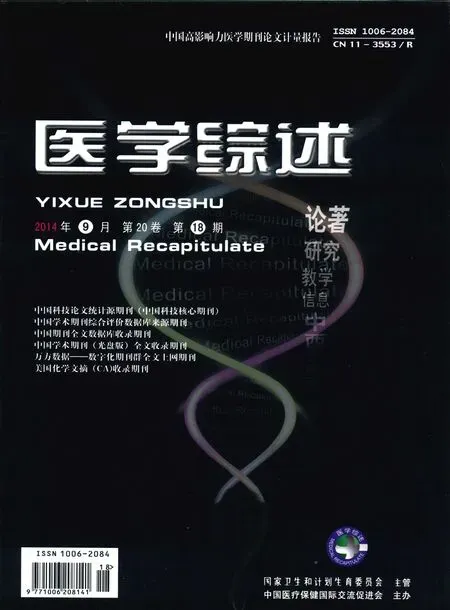重复经颅磁刺激治疗重度抑郁疗效状况及神经机制的研究进展
刘 静(综述),王玉芬(审校)
(天津市安宁医院精神科,天津300300)
重度抑郁是一种高发病率及高致残率的精神障碍,严重危害人类健康,已经成为一个全世界范围内的医学关注重点[1-2]。目前重度抑郁的药物治疗有效率仅为50%,对于药物治疗无反应的患者,目前的治疗措施包括换药治疗,或者合并不同种类的抗精神病药,增加情感稳定剂以及非典型抗精神病药治疗等多种药物治疗措施[3-4]。但是,增加药物后诸多不良反应诸如体质量增加、性功能障碍等也随之增加,尤其是在长期药物治疗患者中,不良反应增加的风险更大,患者依从性严重下降[5-6]。更有约15%的患者对多种药物治疗方案症状改善均不明显,此部分患者也称为难治性抑郁患者。对于难治性抑郁患者或不能耐受药物不良反应的患者,非药物治疗是一种可以选择的方法[7-8]。重复经颅磁刺激治疗于1985年开始应用于神经科疾病的治疗,最初重复经颅磁刺激主要用于评估患者的运动系统功能以及用于研究不同神经精神疾病中不同脑区的作用[9-10]。在过去的20余年中,重复经颅磁刺激逐渐被多个医疗机构用于治疗精神科疾病。到目前为止,世界上多个国家的卫生管理机构已经批准重复经颅磁刺激用于治疗重度抑郁症[11-12],多数临床研究也证明重复经颅磁刺激是一种耐受性好的治疗方式[13]。
近几年来,国际上多个研究采用不同的方法对重复经颅磁刺激治疗的不良反应,安全性、疗效及抗抑郁疗效的神经机制进行了研究,取得了一定的研究成果,现就近年来的重复经颅磁刺激治疗重度抑郁的研究进行简要综述,以增加对此方面知识的了解。
1 关于重复经颅磁刺激治疗不良反应的研究
多个研究明确了重复经颅磁刺激治疗的安全性[14],在重复经颅磁刺激治疗的患者中,最严重的不良反应为引发脑内癫痫发作,但此类不良反应发生的比率较低,较之偶然发生的癫痫发作,低血压性晕厥是相对常见的不良反应,低血压性晕厥常与焦虑以及身心不适存在关联[15]。也有个别报道,在治疗重度抑郁患者过程中,重复经颅磁刺激会引发躁狂或者轻躁狂发作。而重复经颅磁刺激最常见的几种不良反应多为局部躯体疼痛,颈部疼痛,一过性听力下降以及头痛等症状[6]。
2 关于重复经颅磁刺激疗效预测指标的研究
有研究显示,伴有精神病性症状的抑郁、病程较长的重度抑郁患者、伴有前额叶萎缩的老年抑郁患者以及多种药物及心理治疗抵抗的患者均对重复经颅磁刺激治疗反应不佳[16-17]。也有研究显示,首次对重复经颅磁刺激治疗的反应情况也是重复经颅磁刺激治疗疗效的预测指标[18]。
3 关于重复经颅磁刺激部位、刺激频率与疗效的关系研究
McNamara等[19]的一项Meta分析显示,五项不同研究共包括151例患者,其中三项研究刺激的部位为背侧前额叶,一项研究的刺激部位为右侧前额叶,另一项研究为双侧前额叶刺激,刺激频率为1~20 Hz,其分析结果显示,重复经颅磁刺激对抑郁患者疗效明显,而对躁狂发作以及精神分裂症患者疗效不明显。Slotema等[20]的一项Meta分析研究显示,在40个重复经颅磁刺激的研究中,有6项研究与无抽搐电休克治疗疗效进行了比较,34项进行了双盲对照研究;40项研究总计包括1562例患者参与研究,平均治疗时间为1~3周,重复经颅磁刺激频率为0.3~10 Hz;有30项研究采取的刺激部位为左侧前额叶,3项研究的刺激部位为右侧前额叶,7项研究刺激部位为双侧前额叶。Meta分析研究的结果显示,重复经颅磁刺激治疗疗效好于安慰剂治疗,疗效不如电休克治疗。
Shutter等[21-22]系统综述了9项研究共计243例患者经颅刺激的结果显示,在采用0.25~1 Hz的低频磁刺激对重度抑郁发作的疗效与高频刺激疗效接近,都明显好于安慰剂。但是,数据不支持双侧前额叶刺激疗效优于单侧刺激。Lam等[23]研究显示,在24项研究共计1092例样本中,经过1~4周的1~20 Hz高频刺激治疗,难治性抑郁患者的短时间疗效明显好于安慰治疗,但是经过长时间随访,治疗反应率及有效率均较低。Janicak等[24]在美国及澳大利亚的23个临床中心325例样本中,研究评估了重复经颅磁刺激的常见不良反应,在累计100002例的重复经颅磁刺激治疗中,最常见的不良反应为轻度头痛及头皮不适感。Brunoni等[25]的一项研究显示,重复经颅磁刺激与艾司西酞普兰治疗对照,均只有安慰治疗效应,但是重复经颅磁刺激对于难治性抑郁的增效治疗手段是可选的。
4 关于重复经颅磁刺激疗效神经机制的研究
磁共成影像研究显示,在重复经颅磁刺激前后大脑结构未发生改变,体素学分析也未显示前额叶任何改变。然而,很多功能影像学研究显示重复经颅磁刺激后,大脑皮质的兴奋性增高。并且高强度的重复经颅磁刺激较低强度的磁刺激对大脑皮质的兴奋性活化作用更强[26-30]。单光子发射计算机化断层显像研究显示,重复经颅磁刺激对抑郁症状的临床疗效与磁刺激对大脑局部血流灌注的变化有关,治疗有效的难治性抑郁患者表现为重复经颅磁刺激治疗前左侧杏仁核区域脑血流降低,提示局部脑血流降低是重复经颅磁刺激治疗的预测指标。而重复经颅磁刺激治疗后,眶额叶皮质以及扣带回区域皮质脑血流灌注发生改变[31-32]。
另有动物研究显示,单次经颅磁刺激治疗,海马区域出现多巴胺及5-羟色胺升高,长期多次重复经颅磁刺激治疗,则前额叶区域β肾上腺素受体及5-羟色胺受体升高,而纹状体区域的β肾上腺素受体则下调,并且出现突触后5-羟色胺受体自身受体的去敏感化,这与抗抑郁药对突触后5-羟色胺受体自身受体下调的研究结果一致[33-34]。
也有研究显示,重复经颅磁刺激能够影响神经内分泌,健康受试者接受高频重复经颅磁刺激后的正电子发射计算机断层显像研究显示,部分脑区皮质谷氨酸系统代谢增强,其研究结果提示,重复经颅磁刺激能够活化前额叶的谷氨酸神经元[35]。还有研究显示,重复经颅磁刺激能够影响促甲状腺激素释放,地塞米松抑制试验显示阳性,提示磁刺激能够影响甲状腺轴激素水平[36-38]。另有研究显示,重复经颅磁刺激能够改变神经细胞的可塑性以及促进神经细胞的再生,经颅刺激能够促进c-Fos以及c-Jun基因的表达,从而促进海马区域神经元细胞的增生[39-40]。尚有研究显示,重复经颅磁刺激能够影响血脑屏障,有助于血液内药物通过血脑屏障,以达到治疗作用,然而最近的研究结果却无法证实重复经颅磁刺激治疗对血脑屏障的影响[39-40]。
有研究显示,重复经颅磁刺激可以作为重度抑郁维持治疗的治疗方式之一,连续10 d的重复经颅磁刺激能够达到与抗抑郁药相当的治疗效果,而持续至少4周的重复经颅磁刺激临床效果显著,并且低频重复经颅磁刺激较之高频重复经颅磁刺激效果更明显[41]。也有研究显示,重复经颅磁刺激治疗可以作为阿米替林治疗的辅助治疗方式,提高阿米替林的治疗效果[42]。
5 结语
经过近20年来的研究,多数研究结果显示,重复经颅磁刺激作为一种非侵入性的治疗方法,具有较好的治疗安全性以及耐受性,基础研究也显示,能够改善脑区的血流代谢、影响受体水平和神经内分泌、神经可塑性及神经的再生,均提示重复经颅磁刺激具有一定的抗抑郁作用,但是临床荟萃分析的数据不尽一致,其原因考虑与多种因素有关,如重复经颅磁刺激治疗参数的设置、刺激的部位、患者的不同特征和依照研究的设置等,因此关于重复经颅磁刺激的治疗的临床疗效及抗抑郁疗效的神经机制尚需进一步验证。
[1]Berlim MT,Turecki MG.Using psychostimulants for treating residual symptoms in major depression[J].J Psychiatry Neurosci,2007,32(4):304-306.
[2]Nemeroff CB.Prevalence and management of treatment-resistant depression[J].J Clin Psychiatry,2007,68(Suppl 8):17-25.
[3]Sackeim HA.The definition and meaning of treatment-resistant depression[J].J Clin Psychiatry,2001,62(S16):10-17.
[4]Demitrack MA,Thase ME.Clinical significance of transcranial magnetic stimulation(TMS)in the treatment pharmaco resistant depression:synthesis of recent data[J].Psychopharmacol Bull,2009,42(2):5-38.
[5]Dell'Osso B,Camuri G,Oldani L,et al.Current and future perspectives on vagus nerve stimulation in treatment-resistant depression[M]//Rogers EMH,Anderson PB,Eds.Deep brain stimu-lation:applications,complications and side-effects[M].Nova Science Publisher:New York,2009:177-188.
[6]Rossi S,Hallet M,Rossini P,et al.Safety,ethical considerations,and application guidelines for the use of transcranial magnetic stimulation in clinical practice and research[J].Clin Neurophysiol,2009,120(12):2008-2039.
[7]George MS,Lisanby SH,Sackeim HA.Transcranial magnetic stimulation:applications in neuropsychiatry[J].Arch Gen Psychiatry,1999,56(4):300-311.
[8]Levkovitz Y,Roth Y,Harel EV,et al.A randomized controlled feasibility and safety study of deep transcranial magnetic stimulation[J].Clin Neurophysiol,2007,118(12):2730-2744.
[9]Levkovitz Y,Harel EV,Roth Y,et al.Deep transcranial magnetic stimulation over the prefrontal cortex:evaluation of antidepressant and cognitive effects in depressive patients[J].Brain Stimul,2009,2(4):188-200.
[10]Rosenberg O,Shoenfeld N,Zangen A,et al.Deep TMS in a resistant major depressive disorder:a brief report[J].Depress Anxiety,2010,27(5):465-469.
[11]Rosenberg O,Zangen A,Stryjer R,et al.Response to deep TMS in depressive patients with previous electroconvulsive treatment[J].Brain Stimul,2010,3(4):211-217.
[12]Rosenberg O,Isserles M,Levkovitz Y,et al.Effectiveness of a second deepTMS in depression:a brief report[J].Prog Neuropsychopharmacol Biol Psychiatry,2011,35(4):1041-1044.
[13]Roth Y,Amir A,Levkovitz Y,et al.Three-dimensional distribution of the electric field induced in the brain by transcranial magnetic stimulation using figure-8 and deep H-coils[J].J Clin Neurophysiol,2007,24(1):31-38.
[14]Hadley D,Anderson BS,Borckardt JJ,et al.Safety,tolerability,and effectiveness of high doses of adjunctive daily left prefrontal repetitive transcranial magnetic stimulation for treatment-resistant depression in a clinical setting[J].J ECT,2011,27(1):18-25.
[15]Sakkas P,Mihalopoulou P,Mourtzouhou P,et al.Induction of mania by rTMS:report of two cases[J].Eur Psychiatry,2003,18(4):196-198.
[16]Mitchell P,Loo C.Transcranial magnetic stimulation for depression[J].Aust N Z J Psychiatry,2006,40(5):406-413.
[17]Rachid F,Bertschy G.Safety and efficacy of repetitive transcranial magnetic stimulation in the treatment of depression:a critical appraisal of the last 10 years[J].Neurophysiol Clin,2006,36(3):157-183.
[18]Martin JL,Barbanoj MJ,Schlaepfer TE,et al.Transcranial magnetic stimulation for treating depression[J].Cochrane Database Syst Rev,2002,(2):CD003493.
[19]McNamara B,Ray JL,Arthurs OJ,et al.Transcranial magnetic stimulation for depression and other psychiatric disorders[J].Psychol Med,2001,31(7):1141-1416.
[20]Slotema CW,Blom JD,Hoek HW,et al.Should we expand the toolbox of psychiatric treatment methods to include Repetitive Transcranial Magnetic Stimulation(rTMS)?A meta-analysis of the efficacy of rTMS in psychiatric disorders[J].J Clin Psychiatry,2010,71(7):873-884.
[21]Shutter DJ.Antidepressant efficacy of high-frequency transcranial magnetic stimulation over the left dorsolateral prefrontal cortex in double-blind sham-controlled designs:a meta-analysis[J].Psychol Med,2009,39(1):65-75.
[22]Shutter DJ.Quantitative review of the efficacy of slow-frequency magnetic brain stimulation in major depressive disorder[J].Psychol Med,2010,40(11):1789-1795.
[23]Lam RW,Chan P,Wilkins-Ho M,et al.Repetitive transcranial magnetic stimulation for treatment resistant-depression:a systematic review and meta analysis[J].Can J Psychiatry,2008,53(9):621-631.
[24]Janicak PG,O'Reardon JP,Sampson SM,et al.Transcranial magnetic stimulation in the treatment of major depressive disorder:a comprehensive summary of safety experience from acute exposure,extended exposure,and during reintroduction treatment[J].J Clin Psychiatry,2008,69(2):1191-1912.
[25]Brunoni AR,Lopes M,Kaptchuk TJ,et al.Placebo response of nonpharmacological and pharmacological trials in major depression:a systematic review and meta-analysis[J].PLoS One,2009,4(3):e4824.
[26]Nahas Z,DeBrux C,Chandler V,et al.Lack of significant changes on magnetic resonance scans before and after 2 weeks of daily left prefrontal repetitive transcranial magnetic stimulation for depression[J].J ECT,2000,16(4):380-390.
[27]Chen R,Classen J,Gerloff C,et al.Depression of motor cortex excitability by low-frequency transcranial magnetic stimulation[J].Neurology,1997,48(5):1398-1403.
[28]Bohning DE,Shastri A,Wassermann EM,et al.BOLD-f MRI response to single-pulse transcranial magnetic stimulation(TMS)[J].J Magn Reson Imaging,2000,11(6):569-574.
[29]Wassermann EM,Wedegaertner FR,Ziemann U,et al.Crossed reduction of human motor cortex excitability by 1-Hz transcranial magnetic stimulation[J].Neurosci Lett,1998,250(3):141-144.
[30]Teneback CC,Nahas Z,Speer AM,et al.Changes in prefrontal cortex and paralimbic activity in depression following two weeks of daily left pre-frontal TMS[J].J Neuropsychiatry Clin Neurosci,1999,11(4):426-435.
[31]Nadeau SE,McCoy KJ,Crucian GP,et al.Cerebral blood flow changes in depressed patients after treatment with repetitive transcranial magnetic stimulation:evidence of individual variability[J].Neuropsychiatry Neuropsychol Behav Neurol,2002,15(3):159-175.
[32]Ben-Shachar D,Belmaker RH,Grisaru N,et al.Transcranial magnetic stimulation induces alterations in brain monoamines[J].J Neural Transm,1997,104(2/3):191-197.
[33]Ben-Shachar D,Gazawi H,Riboyad-Levin J,et al.Chronic repetitive transcranial magnetic stimulation alters beta-adrenergic and 5-HT2 receptor characteristics in rat brain[J].Brain Res,1999,816(1):78-83.
[34]Gur E,Lerer B,Dremencov E,et al.Chronic repetitive tran-scranial magnetic stimulation induces subsensitivity of presynaptic serotonergic autoreceptor activity in rat brain[J].Neuroreport,2000,11(13):2925-2929.
[35]Michael N,Gosling M,Reutemann M,et al.Metabolic changes after repetitive transcranial magnetic stimulation(rTMS)of the left prefrontal cortex:a sham-controlled proton magnetic resonance spectroscopy(1HMRS)study of healthy brain[J].Eur J Neurosci,2003,17(11):2462-2468.
[36]George MS,Wassermann EM,Williams WA,et al.Changes in mood and hormone levels after rapid-rate transcranial magnetic stimulation(rTMS)of the prefrontal cortex[J].J Neuropsych Clin Neurosci,1996,8(2):172-180.
[37]Szuba MP,O'Reardon JP,Rai AS,et al.Acute mood and thyroid stimulating hormone effects of transcranial magnetic stimulation in major depression[J].Biol Psychiatry,2001,50(1):22-27.
[38]Reid PD,Pridmore S.Dexamethasone suppression test reversal in rapid transcranial magnetic stimulation-treated depression[J].Aust N Z J Psychiatry,1999,33(2):274-277.
[39]Fujiki M,Steward O.High frequency transcranial magnetic stimulation mimics the effects of ECS in up regulating astroglial gene expression in the murine CNS[J].Brain Res Mol Brain Res,1994,44(2):301-308.
[40]Hausmann A,Weis C,Marksteiner J,et al.Chronic repetitive transcranial magnetic stimulation enhances c-fos in the parietal cortex and hippocampus[J].Brain Res Mol Brain Res,2000,769(2):355-362.
[41]Ji RR,Schlaepfer TE,Aizenman CD,et al.Repetitive transcranial mag-netic stimulation activates specific regions in rat brain[J].Proc Natl Acad Sci U S A,1998,95(26):1635-1640.
[42]Li X,Nahas Z,Lomarev M,et al.Prefrontal cortex transcranial magnetic stimulation does not change local diffusion:a magnetic resonance imaging study in patients with depression [J].Cogn Behav Neurol,2003,16(2):128-135.

